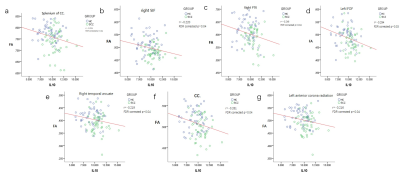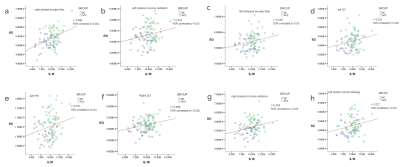1674
Relationship between peripheral Interleukin 10 and white matter integrity in stable medicated schizophrenia1West China Hospital, Sichuan University, Chengdu, China, 2Department of Psychiatry and Behavioral Neuroscience, University of Cincinnati, Cincinnati, OH, United States
Synopsis
To our knowledge, this is the first time to study the association between plasm IL10 level and WM disruption in stable medicated schizophrenia using diffusion tensor imaging (DTI). The present study provided empirical evidence that dysregulation of inflammation contributes to anatomical dysconnectivity in schizophrenia.
Abstract
Introduction: Deficits of white matter (WM) integrity have been widely reported in patients with schizophrenia1,2, while the cause of such changes remains largely unclear. Accumulating evidence suggested that immune mediators may be involved in the pathogenesis of schizophrenia3,4. Interleukin 10 (IL10) has been confirmed to be associated with WM impairment in animal model5 and human preterm infants6. However, it is unknown whether there is any change of IL10 and related WM integrity in schizophrenia patients. The present study aimed to investigate the relationship between peripheral IL10 level and fractional anisotropy (FA) and radial diffusivity (RD) using diffusion tensor imaging (DTI) in clinically stable medicated patients with schizophrenia.
Methods: Diffusion tensor data scanned with 3T SKYRA and IL10 data tested via quantitative chemiluminescent assay (ELISA) were acquired from 47 medicated and stabilized outpatients with schizophrenia and 49 healthy subjects. FA and RD maps were separately processed using FSL 5.0.6 and Tract-Based Spatial Statistics (TBSS). Threshold free cluster enhancements (TFCE) was used for multiple comparison correction with p=0.05 as a threshold for significance. Mean FA and RD of voxel clusters for each participant were calculated from the significant skeletonized maps. Partial correlation analyses controlling for age and gender were conducted to explore the relationships between peripheral IL10 level and FA and RD. False discovery rate (FDR) was used for multiple comparison correction of correlation between plasm IL10 and diffusion measures.
Results: There is no significant difference in age and sex between the two groups (p>0.05). Plasm IL10 level was higher in schizophrenia than control group (p<0.001). Compared with controls, patients with schizophrenia displayed a widespread FA reduction and RD increase (TFCE p<0.05). Interestingly, linear regression revealed that peripheral IL10 level was negatively correlated with FA and positively correlated with RD among all subjects. The voxel clusters showed significant correlation between IL10 and FA were localized in corpus callosum, right superior longitudinal fasciculus, right posterior thalamic radiation, left inferior fronto-occipital fasciculus, right temporal arcuate fiber, right posterior corona radiation and left anterior corona radiation (Figure 1). The voxel clusters showed significant correlation between IL10 and RD were localized in bilateral temporal arcuate fiber, left anterior corona radiation, bilateral posterior thalamic radiation, bilateral posterior corona radiation, splenium and genu of corpus callosum, bilateral superior longitudinal fasciculus and right superior corona radiation (Figure 2).
Discussion: The most important findings of the present study are that significant negative correlation between plasm IL10 level and FA and positive correlation between IL10 and RD among all subjects. To our knowledge, this is the first time to reveal that peripheral IL10 may contribute to impaired WM integrity in schizophrenia, while a previous study found that higher IL10 is relative to WM volume increase in visual areas and tracts7. However, the specific molecular mechanism involved this pathogenesis is still largely unknown. Animal experimental evidence suggests that IL10 may contribute to WM demyelination via microglial activation5 and oligodendrocyte maturation arrest in response to hyperoxia8. IL10 plays a critical role in immunomodulation and maintaining the balance of pro- and anti-inflammatory cytokines levels9,10. Recently, Konasale et al found that serum IL6 and C-reactive protein (CRP) levels is correlated with anisotropy of water diffusion in selected tracts among schizophrenia11. Therefore, it is possible that whether IL10 contributes to WM disruption via the regulation of other inflammatory activities. More studies are needed to investigate the pathways affecting the WM connections.
The present study also demonstrated that stable medicated patients with schizophrenia have higher plasm level of IL10 compared to the controls, which is consistent with previous studies12,13. However, some studies failed to replicate the results14,15. The heterogeneity of IL10 level in schizophrenia may be interpreted by exposure to antipsychotics13, disease severity16 and clinical status17.
Conclusion: The present study provided important evidences that the dysregulation of IL10 relate to the changes of white matter integrity in schizophrenia patients, which support the role of the inflammatory processes in the pathogenesis of schizophrenia.
Acknowledgements
This study was supported by the National Natural Science Foundation (grant numbers 81671664), National Youth Top-notch Talent Support Program of China and the Program for Changjiang Scholars and Innovative Research Team in University (PCSIRT, IRT1272) of China. We would like to acknowledge all participants and the staff of department of Mental Health Center, West China Hospital, Sichuan University for their assistance and participation in the implementation of this project.References
1. Kanaan, R. A., Picchioni, M. M., McDonald, C., Shergill, S. S. & McGuire, P. K. White matter deficits in schizophrenia are global and don’t progress with age. Aust. New Zeal. J. Psychiatry 486741770072 (2017). doi:10.1177/0004867417700729
2. Joo, S. W. et al. Abnormal asymmetry of white matter tracts between ventral posterior cingulate cortex and middle temporal gyrus in recent-onset schizophrenia. Schizophr. Res. (2017). doi:10.1016/j.schres.2017.05.008
3. Hartwig, F. P., Borges, M. C., Horta, B. L., Bowden, J. & Davey Smith, G. Inflammatory Biomarkers and Risk of Schizophrenia. JAMA Psychiatry 1160, 1–8 (2017).
4. van Kesteren, C. F. M. G. et al. Immune involvement in the pathogenesis of schizophrenia: a meta-analysis on postmortem brain studies. Transl. Psychiatry 7, e1075 (2017).
5. Puntambekar, S. S. et al. Interleukin-10 is a critical regulator of white matter lesion containment following viral induced demyelination. Glia 63, 2106–2120 (2015).
6. Ellison, V. J. et al. The Relationship of CSF and Plasma Cytokine Levels to Cerebral White Matter Injury in the Premature Newborn. Pediatr. Res. 57, 282–286 (2005).
7. Willette, A. A. et al. Interleukin-8 and interleukin-10, brain volume and microstructure, and the influence of calorie restriction in old rhesus macaques. Age (Omaha). 35, 2215–2227 (2013).
8. Brehmer, F. et al. Interaction of Inflammation and Hyperoxia in a Rat Model of Neonatal White Matter Damage. PLoS One 7, e49023 (2012).
9. Marie, C., Pitton, C., Fitting, C. & Cavaillon, J. M. IL-10 and IL-4 synergize with TNF-alpha to induce IL-1ra production by human neutrophils. Cytokine 8, 147–151 (1996).
10. Marie, C., Pitton, C., Fitting, C. & Cavaillon, J. M. Regulation by anti-inflammatory cytokines (IL-4, IL-10, IL-13, TGFbeta)of interleukin-8 production by LPS- and/ or TNFalpha-activated human polymorphonuclear cells. Mediators Inflamm. 5, 334–340 (1996).
11. Konasale M Prasad1,*, Catherine H Upton1,#, Vishwajit L Nimgaonkar1, and M. S. K. Differential susceptibility of white matter tracts to inflammatory mediators in schizophrenia: An integrated DTI study. Schizophr Res 161, 119–125 (2015).
12. Kunz, M. et al. Serum levels of IL-6, IL-10 and TNF-α in patients with bipolar disorder and schizophrenia: differences in pro- and anti-inflammatory balance. Rev. Bras. Psiquiatr. 33, 268–274 (2011).
13. Maes, M. et al. Increased serum interleukin-8 and interleukin-10 in schizophrenic patients resistant to treatment with neuroleptics and the stimulatory effects of clozapine on serum leukemia inhibitory factor receptor. Schizophr. Res. 54, 281–291 (2002).
14. Zhang, Q. et al. Increased ratio of high sensitivity C-reactive protein to interleukin-10 as a potential peripheral biomarker of schizophrenia and aggression. Int. J. Psychophysiol. 114, 9–15 (2017). 15. O’Brien, S. M., Scully, P. & Dinan, T. G. Increased tumor necrosis factor-alpha concentrations with interleukin-4 concentrations in exacerbations of schizophrenia. Psychiatry Res. 160, 256–262 (2008). 16. De Witte, L. et al. Cytokine alterations in first-episode schizophrenia patients before and after antipsychotic treatment. Schizophr. Res. 154, 23–29 (2014).
17. Miller, B. J., Buckley, P., Seabolt, W., Mellor, A. & Kirkpatrick, B. Meta-analysis of cytokine alterations in schizophrenia: Clinical status and antipsychotic effects. Biol. Psychiatry 70, 663–671 (2011).
Figures

Negative correlation between plasm IL10 level (pg/ml) and extracted FA from the voxel clusters among all subjects in (a) splenium of CC, (b) right SIF, (c) right PTR, (d) left IFOF, (e) right temporal arcuate fiber, (f) CC, and (g) left anterior corona radiation, respectively. All correlations survived through FDR correction (p<0.05).
Abbreviations: IL10 interleukin 10; CC corpus callosum; SIF superior longitudinal fasciculus; PTR posterior thalamic radiation; IFOF inferior fronto-occipital fasciculus. FDR false discovery rate

Positive association between plasm IL10 level (pg/ml) and extracted RD from voxel clusters among all subjects in (a) right parietal arcuate fiber, (b) left anterior corona radiation, (c) left temporal arcuate fiber, (d) left and (f) right SLF, (e) left PTR, (g) right posterior corona radiation and (h) left anterior corona radiation, respectively. All correlations survived through FDR correction (p<0.05).
Abbreviations: IL10: interleukin 10; SLF: superior longitudinal fasciculus; PTR: posterior thalamic radiation. FDR: false discovery rate